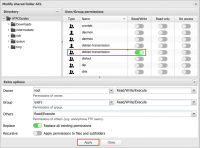

Now we need to enable our newly created server-block by creating a symlink in the /etc/nginx/sites-enabled/ directory: Proxy_set_header Connection $http_connection Proxy_set_header X-Forwarded-For $proxy_add_x_forwarded_for # To generate your dhparam.pem file, run `openssl dhparam -out /etc/nginx/dhparam.pem 2048` (without the quotes) in your terminal. Ssl_certificate_key /etc/letsencrypt/live//privkey.pem Ssl_certificate /etc/letsencrypt/live//fullchain.pem # These are the paths to your generated Let's Encrypt SSL certificates. If you’re wondering how to create a Let’s Encrypt SSL certificate in OMV, I suggest you read this tutorial.Įrror_log /var/log/nginx/openmediavault-plex_error.log error Īccess_log /var/log/nginx/openmediavault-plex_access.log combined Since Let’s Encrypt doesn’t offer wildcard SSL-certificates, you need to generate a seperate certificate for the subdomain serving Plex, e.g.

This tutorial assumes that you’re familiar with creating subdomains and have updated your DNS-records with an A-record pointing towards the system serving Plex. I’ve tried it and although its support forums are bloated with authors claiming they managed to make it work, I couldn’t. plex/web/index.html seems to be unacceptable for the app. I didn’t investigate it any further, but its URL base needs to be /web/index.html. Plex is somewhat authistic when it comes to the routes it uses for requests. I’ve come to the conclusion that this isn’t going to work for Plex.īecause I approach OpenMediaVault at / and Plex doesn’t offer the option to modify the URL base, I’ve chosen to give Plex it’s own subdomain, e.g. If you’ve followed my previous tutorial about reverse proxy’s for Radarr, Sonarr, Transmission and SABnzbd you’re approaching these apps using a Request URI such as /radarr or /sonarr. Initial Obstacles to Consider and Prerequisites Today I’m going to share with you how to create encrypted Reverse Proxy for Plex in OpenMediaVault 2.x using Let’s Encrypt free SSL-certificates. But in the last few days I finally managed to achieve it.

Creating a Let’s Encrypt SSL encrypted reverse proxy for Plex especially. I’ve been messing around for a long time with creating reverse proxy‘s for the applications I use with OpenMediaVault.


 0 kommentar(er)
0 kommentar(er)
